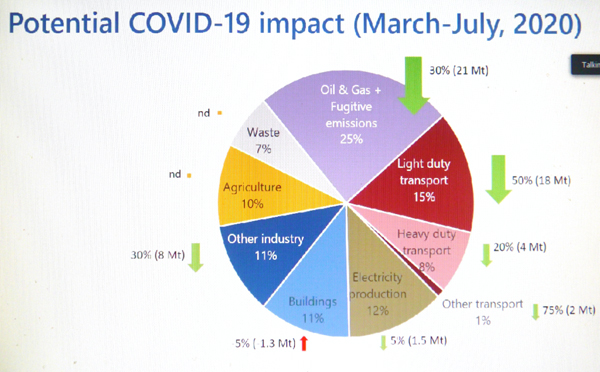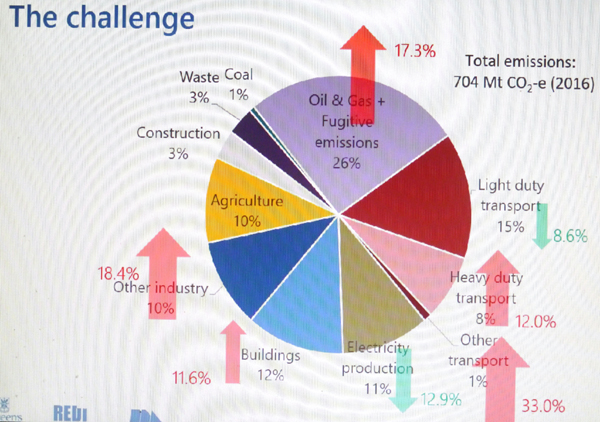Fields Naturalists learn about impact of climate change during COVID and beyond
Administrator | Nov 09, 2020 | Comments 0

By Sharon Harrison
The impact of climate change, ways to adapt, and changes during the pandemic were top of mind for Prince Edward County Field Naturalists listening to a recent virtual presentation by Queen’s University’s Dr. Warren Mabee.

Dr. Warren Mabee
Mabee, an Associate Dean and Director of the School of Policy Studies at Queen’s, also spoke to renewables, how changing energy could impact lifestyles, policies, and how the COVID-19 pandemic has changed aspects.
Mabee is the Canada Research Chair in Renewable Energy Development and Implementation, with a specialty in bio-energy technology and policy. As the Director of Queen’s Institute for Energy and Environmental Policy, he is interested in the intersection between energy issues and other aspects of environmental management.
“I actually have a background as a forester,” he said, “so I started off as a forester who was deeply involved in conservation activities in the ‘80s and the early ‘90s, before I segued, first into being a chemical engineer, and finally some kind of policy expert.”
Energy, he said is the single biggest issue and presents the single biggest solution in terms of managing the climate change crisis.
Dr. Mabee addressed the effects the pandemic has had on emission levels, especially when the country went into lockdown in March.
He noted that because statistics take about two years to compile, full information isn’t yet available, however, he referenced a recent Nature Climate Change publication.
“It suggests daily fossil CO2 emissions for a wide majority of industrialized countries are declining by an average of 26 per cent. These were very early analyses of what was going on with our emissions footprint.”
He said if emissions can be reduced by 26 per cent, something good will come out of the lockdown.
“The thing to keep in mind is that that 26 per cent is almost equivalent to what our seasonal adjustments for CO2 emissions look like.”
He said less fossil energy is used in the summer in many places around the world, where there is a shift from using natural gas to heat to using electricity to cool.
One of the impacts seen has been the big reductions in the oil and gas sector because they have been shut down.
There was also a massive reduction in light-duty transport because people parked their cars and were staying home due to the lockdown.
“That has eroded massively despite the fact that the lockdown is not over, despite the fact that many people have not returned to their workplaces, driving habits are going back up and we can see this through GPS studies we can see that they are driving a lot again, driving on the weekends, driving to the store, visiting friends and lots of different things.”
Heavy-duty transport went down by 20 per cent in the first few months of COVID, but Mabee noted that number has since bounced right back because it was essential supply chains were kept open. He also notes people began ordering more online, increasing the demand for trucks and transport.
Aviation saw the biggest reduction at 75 per cent.
“It’s a good news story, but unfortunately it’s only one per cent of our total emissions, so it doesn’t really take us all the way to where we have to get to if we want to keep our emissions down.”

He said there were some other reductions in emissions from industry and electricity production, but noted an increase associated with buildings.
“People stayed home, but we kept the office buildings heated too, so we actually saw this little bump in demand for buildings,” said Mabee, noting since July a lot has normalized.
“People are driving again and we are not seeing a bounce back in oil production, but we are seeing industry pick-up again.”
He said there has been a demand for electricity, light-duty transport has come most of the way back, and heavy-duty is all the way back.
Mabee states the overall decline is about 50 megatons.
“Keep in mind, our emissions in 2019 were probably about 735 megatons, so you can see that this 53 megaton reduction is not as big as maybe we would like to see,” he said. “And it speaks to how hard it’s going to be to actually reduce our emissions to the levels that the United Nations or climate change scientists are suggesting are required to keep global warming in check.”
Looking ahead, Mabee said we are on track for about a billion tons of CO2 equivalent per year by the year 2100.
“This reflects a number of things: it reflects population growth, so Canada is on track for anywhere between 60, 80, 100 million people by the year 2100, so almost a tripling of what we have now.”
“This growth to a billion tons per annum is actually pretty good because it doesn’t reflect one-to-one emissions, it reflects better and better management of what’s out there, but it’s still a significant problem that we need to address if we really want to deal with climate change,” stated Mabee.
Showing a slide on how climate change can be mitigated and emissions reduced, Mabee highlighted seven areas. They included eliminating coal, electrifying cars, improving trucks (bio-fuels, hydrogen and other fuels being options), as well as making the electricity supply completely green and making net-zero buildings.
He noted there is more that can be done with agriculture and forestry. However, the largest area covered was conservation.
“This is equivalent to a five-fold reduction in every Canadian’s average energy use,” said Mabee
“If in a day for example, you use the equivalent of one megawatt we’ve got to get it down to about 200 kilowatts in order for it to be where we need to be in this particular model.”
He noted in many European countries, the average energy footprint is a third to a quarter of what Canadians use.
“When you think of the quality of life in France and Germany, you start to realize there are lots of things we can do to get there, lots of ways of living better.”

Mabee noted that electrifying power is happening relatively fast, especially when it comes to electric cars where sales have doubled every year for the last six or seven years, but points out that electric cars need to be manufactured in Ontario.
Mabee said reliance on diesel fuel has to be addressed as its use continues to rise with more trucks on the road, especially as more people are ordering more stuff online.
“In a post-COVID world, I don’t see this getting smaller, I see it getting bigger because the post-Covid world is increasingly looking like people will decamp the cities and they will chose to locate somewhere that is less dense, where they can have a backyard, where they can have a home office, where they can do the things they want to do.”
“If we can’t get people to live cleaner, we will have a big problem with meeting any of our goals, of aiming to get our emissions down to zero by the year 2100.”
Mabee noted that carbon pricing is the most important tool to help with conservation.
“Carbon pricing as opposed to what a lot of people think is not designed to bring people’s activity down by making everything too expensive, it’s meant to provide a signal so that you can chose the cleaner options.”
He also spoke to the benefits of green electricity.
“What’s amazing about green electricity is that every year there are new options and the options that we have are getting better and better and more efficient where we are going to end up with green electricity is our cities, and our buildings are going to generate the power they need to operate and that will lead to net-zero homes.“
He said there were a lot of growing pains associated with green electricity, for instance, with wind farms.
“Wind farms can be a very effective and very cost-effective way of generating green electricity, but they require significant amounts of planning,” he said. “Arguably, the biggest mistake Ontario made was not doing the planning up-front and thinking about where these things really belong and where should they be put into play which has been expensive.”
Mabee said the real options are with net-zero buildings, noting net-zero single family homes are being built as a lot of the technologies are off the shelf.
“A net-zero building or a net-zero type of construction is a building, a house, an office building, a condo tower that produces as much energy as it needs.”
However, he noted that option is not always perfectly synced to times of the year. For example, when building needs energy to come in, and times of the year when energy is leaving the building cannot always be controlled.
He said the difficulty of net-zero buildings is with tall buildings.
“An all-wood building means it takes a lot less energy to build it, its highly energy efficient, it’s not net-zero yet, but we are moving in the direction where we can start to build these buildings with a much better footprint that what we are building today.”
Dr. Mabee said the biggest problem that will arise over the next 30 years as climate change is dealt with is going to be with tall buildings.
“It’s going to be the cities like Toronto, Vancouver and Montreal that has hundreds, if not thousands, of tall buildings that are not particularly energy efficient that will require very expensive retrofitting.”
“We can get to the point these buildings are net-zero where not only is the amount of energy that goes into them low, but the energy that they produce through roof top solar, solar windows, the idea that you have windows that can actually generate power, passive solar, they are many things that can be brought into play with these buildings.”
From an agricultural or forestry perspective, Mabee said the energy that goes into the machines needs to be addressed, along with the fertilizers used and practices in general.
“There is a lot to be learned from old ways of running farms, old ways of doing forestry that are much lower impact than what we do today,” said Mabee. The trick is we can do it, but we can’t lose the efficiency gains that we have seen because part of the reason we can all live together on this planet is because of the green revolution.”
“The fact that we increase agricultural production so much over the base line over the relatively low yields that we used to see, there are a lot of people on the planet and giving up those gains is going to make a lot of people hungry, so we need to not go backwards, but go forward and learn from the past.”
Electricity production in Canada accounts for 11 percent of emissions, buildings (heating and cooling buildings) is 12 percent, steel production and manufacturing is 10 percent, agriculture is about 10 percent, but Mabee notes that’s not just the energy used to do the agriculture, but the emissions that come from agricultural practices, like fertilization.
He said construction, waste management and the mining of coal consists of about one percent of emissions, a small but important number.
Addressing emissions, Mabee said until very recently, emissions relating to the production of oil and gas, among other areas, were going up.
“Heavy-duty transport emissions were going up, other transport like aviation emissions were going up in a hurry, we were seeing big gains over a 10 year period,” stated Mabee.
“Emissions for buildings were going up and not just because we were building more buildings, but because the way that we build buildings has changed.”
He said emissions from other industry were going up, something he noted is both bad and good.
“It means on one side, we have more industry happen and more jobs and more development, but on the other side, it is leading to some bigger overall emissions and that’s an issue.”
Mabee noted two areas where emissions are going down are light-duty transport and electricity production.
“With light-duty transport, the use of gasoline is being offset first by bio-fuels and now by electric vehicles, so we are seeing a little bit of a reduction there.”
He said it’s no surprise these two areas are seeing reductions because a lot of time, money and policy have been invested to try to bring emissions down.
Mabee also noted there have been a lot of green electricity projects funded across the country to get people to use more bio-fuels, such as ethanol, or to shift to electric cars.
“Those are places where we can see where policy is working and seeing those emissions coming down,” he said.
The Prince Edward County Field Naturalists’ next meeting is Tuesday, Nov. 24 at 7pm, via the Zoom internet application. All are welcome to hear Tim Johnson, Great Lakes Research Scientist speaking about a changing Lake Ontario.
Filed Under: Featured Articles
About the Author:
































